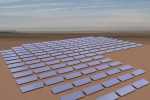County P&Z recommends renewing permit for solar plant

Efforts to build a large-scale solar energy complex southwest of Mountain Home gained new traction this month after the county's planning and zoning commission recommended plans to renew its initial permit.
During a public hearing March 6, the eight-person commission unanimously recommended approving a conditional use permit for the first phase of the Grandview PV Solar One project.
The company heading the project was required to resubmit the permit, limited to the first phase of the overall project, after a one-year extension expired in January.
Located off the Grand View Highway in a 180-acre field leased from the J.R. Simplot Co., the 20 megawatt generating facility is part of an overall four-phase project that would product up to 80 megawatts of solar-generated electricity when complete. The 20 megawatts generated by each of the four solar farms is equivalent to the annual energy usage of 6,000 homes in Idaho.
Pending final approval by the board of county commissioners, the resubmitted permit included a request to give the company two years to resolve any outstanding issues with the project versus the standard one-year time limit.
During the March 6 meeting, the planning and zoning commission approved two additional requests submitted by the solar company to extend the conditional use permits on the third and fourth phases of the generating complex. Both of those projects were originally approved by the county last May.
These additional solar plants would tie into the first and second sections, located on the eastern and western boundaries of the Nicholson Ranch.
When county officials approved the first phase in April 2010, the solar plant possibly represented the first of its kind in Idaho, said Robert Paul, managing member with Alternative Power Development Northwest LLC, which submitted the permit. The project's second phase was approved in January 2011.
The project provides places like Elmore County a "tremendous economic opportunity," without the environmental concerns associated with fossil fuel power plants, Paul said in a previous meeting before the planning and zoning commission.
However, the project missed a key deadline to deliver electricity to Idaho Power. The Grandview PV Solar One project was scheduled to deliver up to 20 megawatts of electricity to Idaho Power by Jan. 12, but the date came and passed. It fueled uncertainty over the project's fate, which would've dealt another blow to the state's struggling alternative energy industry.
In his opening comments at the recent hearing, Paul said the solar energy facility remained "embroiled with public controversy over renewable energy" in recent months.
Key to this controversy was a Power Purchase Agreement submitted to the Idaho Public Utilities Commission in June 2010. The agreement sought to pave the way for the Grand View solar complex to sell its power output to Idaho Power.
However, with the solar complex not completed by the January deadline, the Grand View company requested to voluntarily end that initial agreement. The motion filed with the state public utilities commission included a confidential settlement between the solar firm and Idaho Power.
Meanwhile, Grand View PV Solar One faced a separate legal battle with Walbridge East LLC, which was expected to design and build the solar plant. A civil case filed with the U.S. District Court in Boise alleged that the construction firm was "stiffed" on work it had completed on the project.
Once these issues are resolved, the company expects the process of building the solar complex to move quickly, Paul said.
In September 2012, the project appeared to be moving forward and was expected to represent a rare bright spot in Idaho's alternative landscape where wind and dairy biogas projects were being canceled. At that time, the solar company's owner, New York-based Mark Scher, had said the company would begin installing about $30 million worth of solar panels within a matter of weeks.
The solar complex is one in a series of alternative energy projects in Idaho that ran into complications and legal hurdles in recent months. Numerous other projects across the state were also scuttled in recent months.
For example, the Exergy Development Group LLC in Boise mothballed some $323 million worth of wind projects as well as separate digesters that were to have been located at southern Idaho dairies.
Idaho only recently completed a rewrite of rules governing alternative energy projects in the state that developers like Exergy have blamed for turbulence in their industry, in particular with finding financing.
What's more, Idaho has no renewable portfolio standard like Washington and Oregon that sets long-term mandates for regulated utilities to buy renewable power like the kind generated by wind or solar projects. Without such a standard, environmental groups say individual projects like Grandview will struggle to succeed because utilities like Idaho Power have little incentive to work with them through challenges.
"There's all sort of hurdles and disagreements," said Idaho Conservation League's Ben Otto, who advocates for more renewable energy sources. "When you get down to the nuts and bolts, it doesn't actually work" without a renewable portfolio standard.
The project provides places like Elmore County a "tremendous economic opportunity," without the environmental concerns associated with fossil fuel power plants, Paul said in a previous meeting before the planning and zoning commission.
Each of the four solar generating complexes would include approximately 78,000 solar panels, each measuring three by five feet. These panels will sit on steel, A-frame structures known as barns. Angled to catch the most sunlight throughout the year, each of these structures will rise more than seven feet off the desert floor.
Similar to first-generation mass production solar cells developed in the 1950s, the generators in the Grand View project use the latest advances in photovoltaic technology, which converts absorbed sunlight into electricity. A matte finish on each panel provides additional benefits by absorbing sunlight without the reflective glare of earlier solar cells, Paul said.
The two additional solar farm projects would includes hiring up to 80 local contractors during the expected six-month construction phase.
